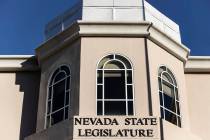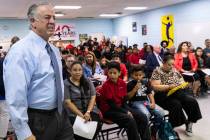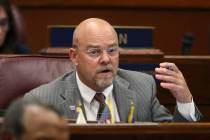Don’t kill downtown!
Downtown Las Vegas has undeniably experienced a renaissance during the past 12 years or so. Once-seedy streets have yielded to hipster outposts, art galleries and high-rise condos that at one time would have been seen only on the Strip.
The culture and nightlife resurgence is the result of the hard work and commitment of many downtown business owners who took a risk, not only in opening a business, but in opening a business in a part of town that was long neglected. Oscar Goodman’s mayoralty put those people and their work on the map.
And that work was instrumental in attracting the attention of people such as Tony Hsieh of Zappos.com, whose company is pumping millions into downtown to continue the transformation into a high-tech zone filled with creative-class types. (Full disclosure: My wife works for a public relations firm that promotes downtown.)
But downtown still has a long way to go. It’s still not the destination of choice for many in the valley, and it still struggles to combat the image – and sometimes the reality – of things that put the grit in gritty urbanism.
What downtown certainly doesn’t need is more hurdles. But it seems that’s just what it’s getting.
Wes Isbutt told the Review-Journal’s Benjamin Spillman last week that he’s planning to leave town after 15 years of helping to build culture downtown. The man behind the Arts Factory building on Charleston Boulevard says it’s just too expensive for him to participate in community events such as First Friday, the monthly community arts festival that struggled with rising costs until it was purchased by the Zappos people.
Isbutt said the breaking point came after he was required to hire off-duty police officers to meet new security requirements. The cops go for $66 per hour per officer, which Isbutt calls “extortion.”
Those costs led Isbutt to cancel his participation in the May 4 First Friday; he said the cost of the extra police would erase his profits.
Police and city officials respond that the need for security and order during First Friday is important, and they would face criticism if there were an incident that could have been prevented. But surely there’s a way to manage the costs that doesn’t force people to cancel their participation in downtown’s signature event.
High security costs aren’t the area’s only government-inspired problem. The hardest working public employees in the valley are surely those who monitor downtown’s streets for illegally parked cars. In a town where free parking is very nearly a constitutional right, harassing visitors who’ve overstayed their welcome at a meter is hardly a way to drum up repeat business. (The city has hired a parking “czar” and promises reforms. Let’s hope those include easing parking rules where it makes sense, but preventing all-day parking in front of downtown’s small businesses.)
Then there’s the hulking Neonopolis, a government-driven project that struggled for tenants even during its multiple groundbreakings. A city-owned parking garage underneath the seldom-visited mall is still costing taxpayers money. (The city says it will be paying off the garage soon.)
Contrast that with the government’s action in reducing stratospheric liquor-license fees in the East Fremont corridor: As a result, a slew of very cool bars sprung up, and they draw more people to the area. The city loses out on fee revenue, but cashes in on sales of drinks and food.
It’s usually possible to trace regulations – even ones that seem stupid – to something bad that happened at some point, and the desire to prevent a recurrence. But it’s not hard to find regulatory overreactions, too. And in downtown’s case, overreactions could stall or even kill a renaissance that a lot of people have worked hard to make happen. That would be a shame.
Steve Sebelius is a Review-Journal political columnist and author of the blog SlashPolitics.com. Follow him on Twitter (@SteveSebelius) or reach him at (702) 387-5276 or ssebelius@reviewjournal.com.












